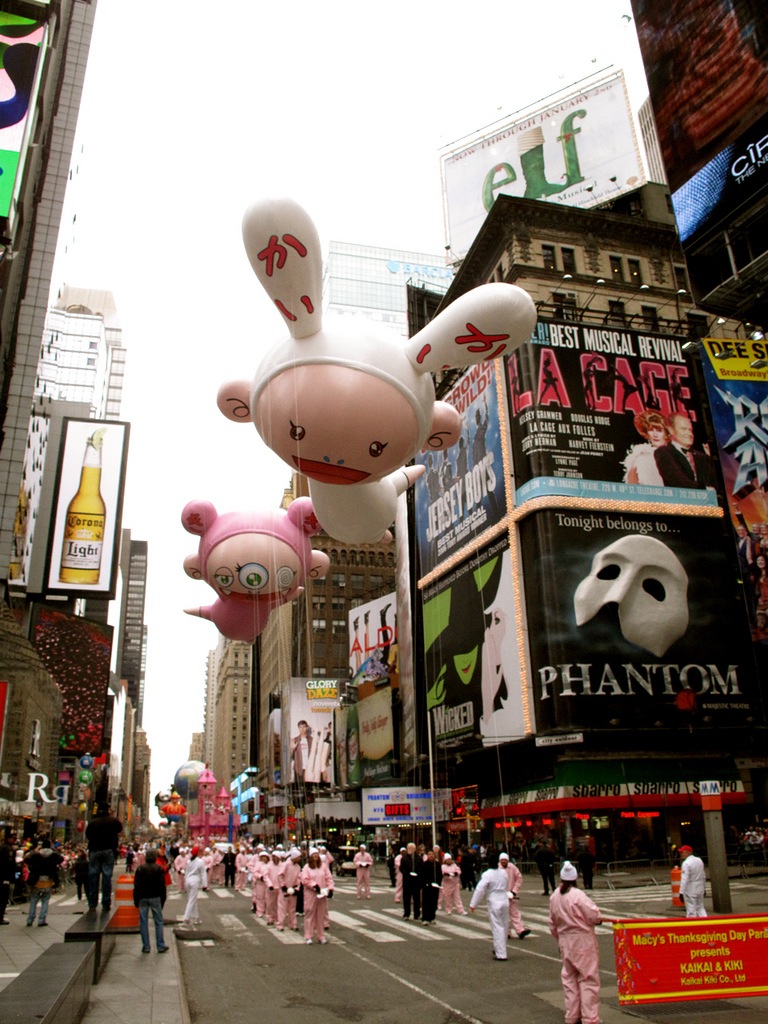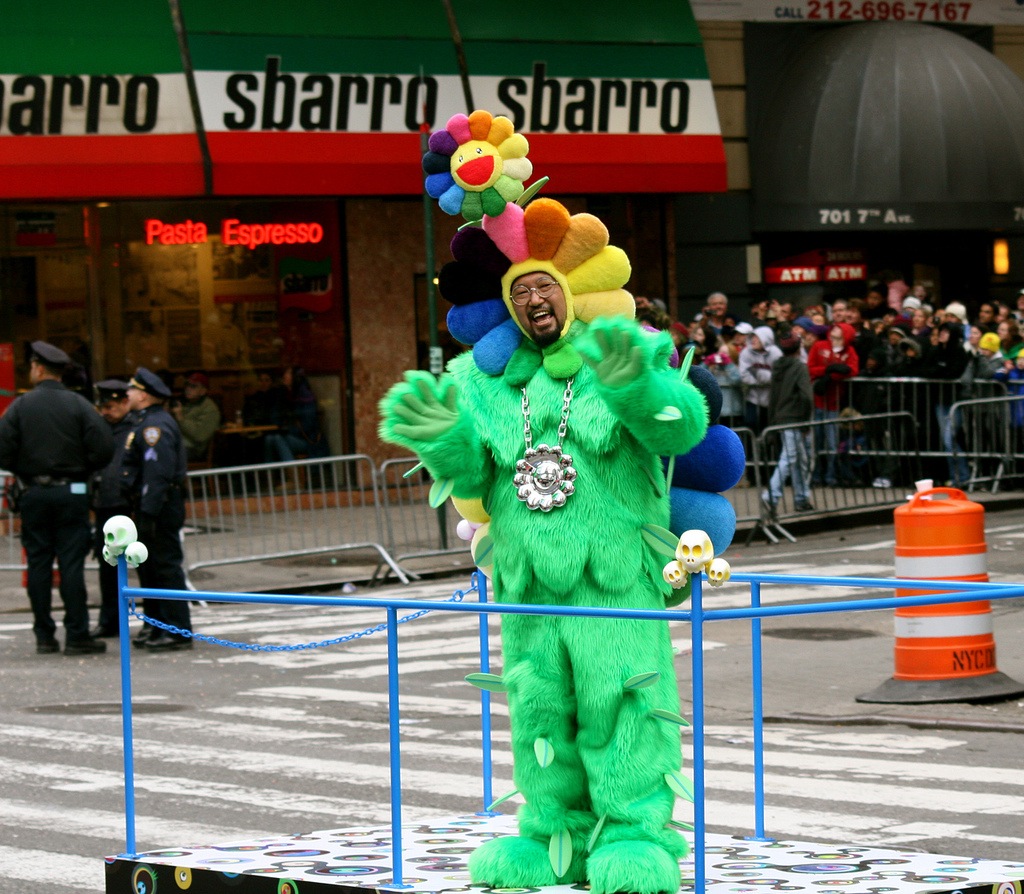
It is not uncommon for people to react with awe to their first up-close encounter with a balloon from the Macy’s Thanksgiving Day Parade. But when Takashi Murakami saw his contributions to Thursday’s event, he bowed. Twice.
On Wednesday afternoon, on a stretch of West 81st Street in Manhattan where brightly colored, 30-foot-tall inflatable versions of his characters Kaikai and Kiki were wriggling and writhing underneath a huge net, Mr. Murakami, the Japanese pop artist, held a brief Shinto ceremony for purity and luck. He stood at a table where he poured out a glass of water and a glass of sake in front of two plates, one of white rice and one of sea salt. He gave two bows and clapped twice, then declared the ritual complete.
Kaikai, a childlike character in a rabbit costume, and Kiki, an impish figure with three eyes and two dangling fangs, were ready to greet the parade-watching public.
In an interview after the ceremony Mr. Murakami, his bushy hair tied in a knot, seemed exuberant. He said he was less concerned about whether Kaikai and Kiki — who do not promote any television cartoon shows or breakfast cereals, and are merely ambassadors of Mr. Murakami’s own playfully esoteric art — could hold their own in the Macy’s parade than about Thursday morning’s weather.
“I was thinking about sunshine,” Mr. Murakami said in his broken English. “Tomorrow the report is a little bit rainy. But I already talk with my feng shui master in Taiwan, and he already take care about that.”
For the organizers of the Macy’s parade the addition of Mr. Murakami and his characters to its lineup is the fulfillment of a longtime goal and several years of work.
Robin Hall, the executive producer of the parade, said in a telephone interview that Mr. Murakami was one of a handful of artists Macy’s sought out when it started its series of balloons designed by internationally recognized artists in 2005.
The parade, Mr. Hall said, “is a snapshot of American culture.” While much of its roster is dedicated to readily identifiable figures like SpongeBob SquarePants and Dora the Explorer, he said, “I do believe there’s room in this parade — and have always believed this — for high art.”
In that spirit the sculptor Tom Otterness created a Humpty Dumpty balloon for Macy’s in 2005, depicting that nursery-rhyme character suspended upside-down in a perpetual tumble.

In 2007 the parade added a shimmering silver rabbit designed by Jeff Koons, and the following year incorporated a giant Keith Haring figure holding up a heart, to mark what would have been the artist’s 50th birthday.

In 2008 Macy’s also began communicating with Mr. Murakami, who in the global art scene is known as much for his inflatable sculptures of psychedelic anime-style cartoon characters as for the Louis Vuitton handbags and Casio watches he designs. But at that time he was preparing for a retrospective at the Brooklyn Museum and could not immediately contribute to the parade.
This year Mr. Murakami sent word that he wanted to create balloons of Kaikai and Kiki. In response to e-mailed questions, he explained that the characters “in many ways represent the aesthetic philosophy behind my work.”
“They are cute yet fearsome,” he wrote, “modern and yet connected to the past. They embody eccentric beauty.”
The Macy’s parade studio in Hoboken, N.J., had only a few months to work on the designs with Mr. Murakami. Of particular concern to John Piper, the vice president of the studio, was whether the balloonified characters, with their gigantic heads and teeny-tiny limbs, would be able to achieve what he called free lift — meaning, Mr. Piper said, “that there’s enough helium inside the balloon to not only compensate for its weight but to make it fly.”
At an accelerated pace Mr. Piper and his team exchanged sketches with Mr. Murakami and his staff, and over the summer Mr. Piper chaperoned two small clay sculptures of the balloons on a trip to the artist’s Tokyo studio. (The sculptures, Mr. Piper said, traveled in “a very big, very sturdy piece of luggage, inside of which was a whole other steel structure to absorb any shock.”)
The completed balloons were flown for the first time this month at a Macy’s testing facility in South Dakota, but Mr. Murakami — who plans to accompany them in the parade wearing a flower costume of his own design — had not seen the finished works until Wednesday.
Nor, for that matter, have the thousands of children who will watch the parade live — or the millions who will watch on television — Thursday morning, and have likely never heard of Mr. Murakami.
Mr. Hall acknowledged that Kaikai and Kiki’s mix of cuteness and weirdness was pushing boundaries for Macy’s. “There are details about them that, I think in isolation, as they’re described, sound kind of grotesque,” Mr. Hall said. But, he added, “the final thing is not so bad.”
Ultimately, Mr. Hall said, Macy’s criterion for its parade balloons is “not a question of: Will the kids recognize it?”
“Our rule here,” he continued, “is whether the kids understand it or not? Will the kids like it?”
Watching the inflation of Kaikai and Kiki on 81st Street, Tami Marsden and her son Alex, 6, were less sure about what they were seeing.
“We don’t know who that is, but he knows Kung Fu Panda,” Ms. Marden said, indicating another nearby balloon. “I thought it was a Pokémon thing.”
She added: “I hate to say it, but boys really don’t like anything that’s pink.”
Art Inflation: Macy’s Murakamis
By Dave Itzkoff from The New York Times
________________________________________
And some pics from the parade from Arrested Motion:






